Posted by Patrick Weiler on 09-04-2002 10:42 PM:
Wedding Rugs ?
The following topic is rated R-17 and may not be suitable for younger
audiences

There has been speculation that the engsi was part of the dowry and may
not have seen heavy use on a daily basis. This may account for the number of
engsi's in good condition today. :
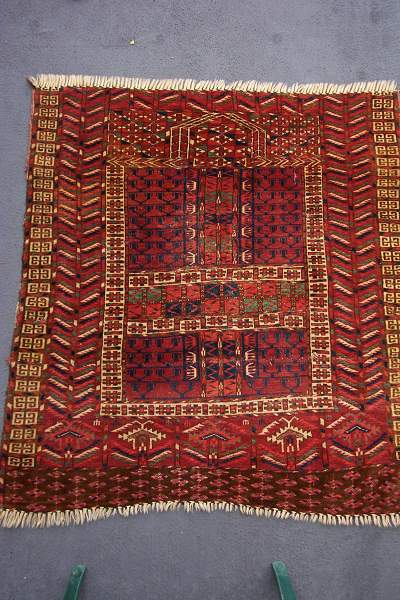
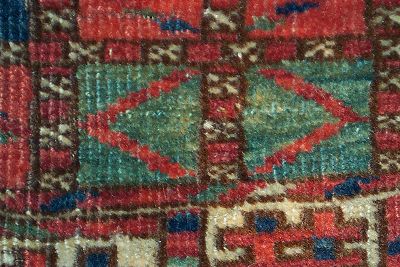
This particular engsi was deaccessioned from a local
museum. There is a lovely green used here that is not common. It appears to be
missing about an inch (cut and shut) approximately 1/3 up from the bottom and
is missing most of the original selvages and an inch or two from the top and
bottom.
If the engsi was woven for the wedding ceremony, perhaps the
iconography was related to the upcoming marriage.
The caldelabra or tree
motif could represent abundance, fertility and wealth. The tree motifs on this
engsi appear to be grape vines:
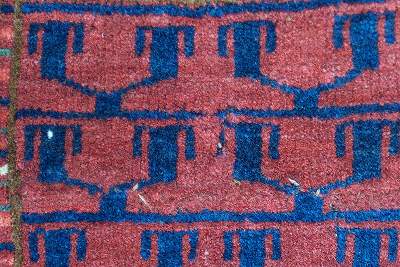
The
actual pictorial representation of the impending joining of the couple may not
have been a suitable subject for display, so an abstract symbolism may have
been used instead to represent the process, with the phallic trees at the
bottom:
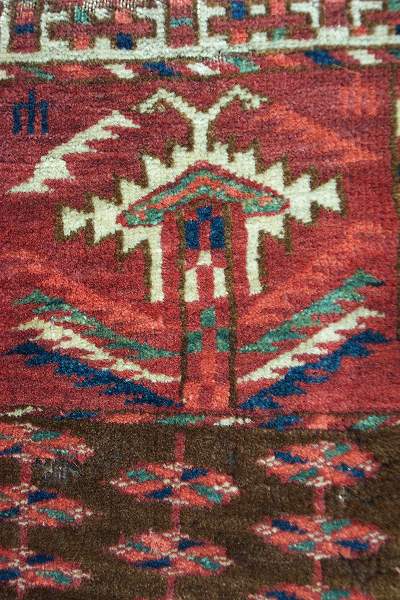
and the, well you get the picture:
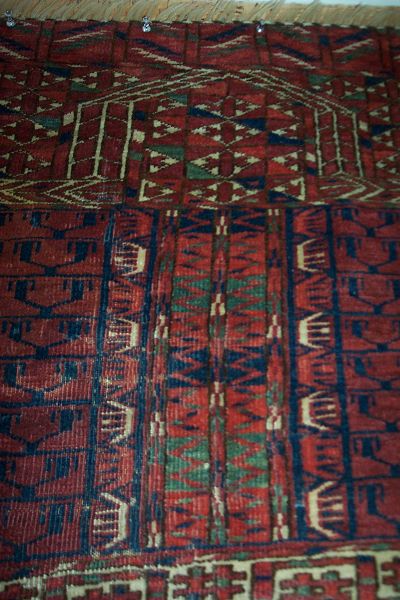
India is famous for erotic sculpture, the Japanese culture
put a picture book under the pillow of the newlyweds and created stunningly
realistic netsuke of sexual poses. Perhaps the engsi was the Turkmen version of
the Kama Sutra...
Patrick XXX Weiler
Posted by R. John Howe
on 09-05-2002 07:08 AM:
Patrick -
Interesting thoughts, but I doubt that good "country
people," as the Turkmen seem to have been, were prudish about
sex.
George O'Bannon once gave a presentation at the Textile Museum and
presented a Turkmen weaving that had a wedding train as part of its design. One
of the male animals in this train had a conspicuous full erection as he walked
along. Pretty explicit. No resort to abtraction at all.
Have you noticed
that folks who live closer to nature tend to be more matter of fact about "the
facts of life?" It's we "townies" who get hidebound about such things. This
pattern is evident in the rug producing areas too, with the nomad women not
being subjected to many of the restrictions that were imposed on folks in the
towns who apparently had more time to think things up.
One additional
thought. Mugul Andrews, writing in OCTS, V, Part 1, discusses "Turkmen wedding
rugs." She is not entirely sure that there were such rugs in traditional
western Turkmen weddings, despite the fact that she saw and talked to a young
Turkmen girl who claimed to be weaving one in 1970. Andrews describes such rugs
as generally quite small, (3' X 3" or 3' X 4') and notes that design seems not
to have been important any longer in 1970, since the Yomut girl was weaving a
recent and quite conventionalized "Afghan" design. So at least by the 1970s any
importance that the designs that "wedding rugs" may have once had in western
Turkmen society seems to have be lost.
Regards,
R. John Howe
Posted by Filiberto Boncompagni on 09-05-2002 10:15 AM:
Good Gad!
There are SOME people on this site with a wicked,
vicious, depraved (and so on…) fantasy.
I’m afraid this is just
the beginning...
I had a revelation: next salon will be WORST!
Beware!!!
Sooth-saying,
Filiberto
Posted by Steve Price
on 09-05-2002 10:35 AM:
Dear Friends,
The subject of sexplicit imagery comes up (did I
really say that!) from time to time. Most recently, in Salon number 68
(http://www.turkotek.com/salon_00068/s68t5.htm), about a
year ago.
So, let's go straight to the most extreme statement. Here's
an image, reproduced from HALI #58, p. 71.
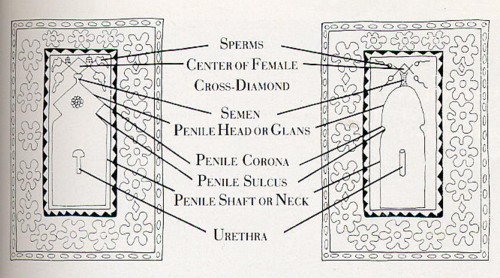
The caption says, According to Dr. John Douglass, these drawings
show a "Melas prayer rug (19th century) depicting an ejaculating penis compared
to an anatomical sketch of an erect penis." Reproduced from Douglass &
Peters, The Lost Language (1990), vol. 1, p. 35. I just love the idea of
putting floral borders around anatomical sketches, and will share that with my
friends in our Department of Anatomy.
Now that we've got that behind us
(omygod, did I say that!), let's get back to the
subject.
Regards,
Steve Price
Posted by Sue Zimerman
on 09-05-2002 08:13 PM:
Hi Everyone,
Sorry to disappoint you, Marvin, with my inconsistency.
I have changed my mind.
Thank you, Patrick for starting this thread and
posting this Engsi.
Thank you Steve and John, too, for your postings
responding to mine.
The puzzle pieces continue to fall into place. If the
Turkmen are "shamanic" then one of the overlays of meaning in their
Engsis/insignias/signs may be as a signal for "initiates" of what was yet to
come. (Sorry for the pun).
What I was thinking of as the meaning of a
simple sky map showing migration cycles of a nomadic people is much more than
what I was thinking it was. I was thinking of the vertical band of the hatchli
as the former migration and the horizontal band as the eminent one. One of the
things which has been bothering me about this idea is the time frame. Engsis
took so long to weave. Why would the have relevance for only one year, or even
many years? I figured the engsis/"signals" must be portraying more than a
simple seasonal change.
Persian miniatures are very interesting. Look
at the faces in them. All races are represented. These are certainly not
peasants, either. The "Turkman" leaders wear crowns and wear green. Green, I
have read, is a color held sacred by Muslims. The Oriental representatives sit,
cross-legged on small yellow carpets. Yellow, in China, was the color reserved
for Imperial use. Anyone know which culture used red? I don't.
The rugs had
rounded edges and the tents were unbelievably beautiful. Please excuse this
digression, I think others may be interested in seeing some weavings of the
past in pristine shape, as I do.
What if the vertical hatchli
"migration" band on the engsis/ "insignias"/"signs" were used to signal the
eminent migration of, say, power, wealth, knowledge from the "Muslim" seat of
power to the "Christian" world? What better engsi, or, as we call it in the
West "logo" for the "shamen" to use than the rape of the mihrab?
Quite an
accurate "shamanic prediction" if one cares to think about it.
Why,
John, would the very funders of conventional knowledge, those who select and
pay to educate such people as Dr. Sheila R. Canby, allow her, an employee of
the British Museum -- another creating center of conventional knowledge, say,
in a beautiful coffee table book, in 2000, the following.
"The
turkmans, timurids, ottomans, and mamluks were the great established powers of
the late fifteenth century east of the Bosphorus and west of Pamirs
..."
Could the red double crosses on the "shaft" of the vertical band of
the hatchli Patrick posted have something to do with, say, tainted blood,
delivered, say, by some sexually transmitted disease?
Well, the leaves
are falling and soon the birds will start to gather and loudly start practicing
for migration and I, for one, am glad that I have my money safely in a rubber
band as the oily dark clouds appear on the horizon. Sue
Posted by
R. John Howe on 09-05-2002 09:10 PM:
Ms. Zimerman -
Distinctions are important when we talk about "the
Turkmen."
I bought a book on eBay this week with lots of color photos of
"Turkmen Costumes." But it's not about the costumes of the Central Asian
Turkmen whose rugs we collect but rather of some Turkmen groups that migrated
early (10th and 12th centuries) into northwestern Turkey (approximately in the
Bergama area).
So the British Museum scholars can make sweeping
statements that flow at a different level than does the focus of our
conversation here and seem to contradict us without doing so.
The
semi-nomadic Turkmen who made the engsis were located east of the Caspian and
for a distance east in the former Soviet "stans." Some were in a little part of
northeast Iran and in northern Afghanistan. Some more general statements about
"the Turkmen," do not necessarily refer to them.
Regards,
R. John
Howe
Posted by Patrick Weiler on 09-05-2002 10:35 PM:
Sue,
I, too, am a firm (is that the right word to use in a thread
about the possible sexual interpretation of Turkmen iconography?) believer in
the importance of the celestial sky to ancient peoples. I have even posited
that the ubiquitous "latchook" medallion could represent a supernova.

History shows:
"Arab astronomers reported a new star in 1006 AD.
* Chinese astronomers reported a "guest star" in 1054 AD (as well as the
1006 supernova and one in 1181).
* Tycho Brahe reported a new star in 1572
and Johannes Kepler one in 1604. The fact that new stars could appear in the
sky helped overturn the idea of the immutable heavens.
* These were all
visible with the naked eye and occured in our own galaxy."
The sky was
their evening television, their library, their almanac.
Without a written
language, the need to pass along the wisdom and knowledge accumulated over
hundreds of years in a format simple enough to be used by the least learned
disciples meant that they needed to use the few tools they had at hand;rugs.
Various designs were used as touchstones upon which the elders could elaborate
a common heritage to their students.
What we are left with is their
pictorial schoolbooks without a Rosetta Stone to interpret them with.

Granted, it is with tongue firmly planted in cheek that I put forward
my hypothesis regarding the "sex education" format of the engsi.

There is so much
"static" in the form of the readily changeable iconography of rugs between the
time of origin and the various "interpretations" produced by countless
illiterate weavers that the true original meaning has doubtless been lost in
the distant mists of time.
Patrick Weiler
Posted by Sue
Zimerman on 09-05-2002 10:54 PM:
Dear John,
I see. Sue
Posted by Sue Zimerman on
09-05-2002 10:55 PM:
Dear Patrick,
I see. Sue
Posted by Vincent Keers on
09-07-2002 05:53 AM:
Dear Patrick,
From a female perspective all engsi's are upside
down.
Best regards,
Vincenta
Posted by David R.E. Hunt on 09-07-2002 07:06 PM:
Wedding Rug
Greetings all- R.J. Howe's assertion of encountering a turkmen woman in
the 1970's who claims to have woven a wedding carpet in a non traditional
design suggests to myself annother plausible explanation of the wedding carpet
phenomonon. Maybe the small size, crooked and distorted shapes of these rugs
are the result of a neophytic execution, roughly analogous to the needlepoint
sampler of yesteryear here in the west. Perhaps a better explanation than some
of the "flying Gul" theories being bandied about. - Dave
Posted by
Sue Zimerman on 09-07-2002 07:17 PM:
Dear David,
Maybe, maybe not. xxxooo, Sue






